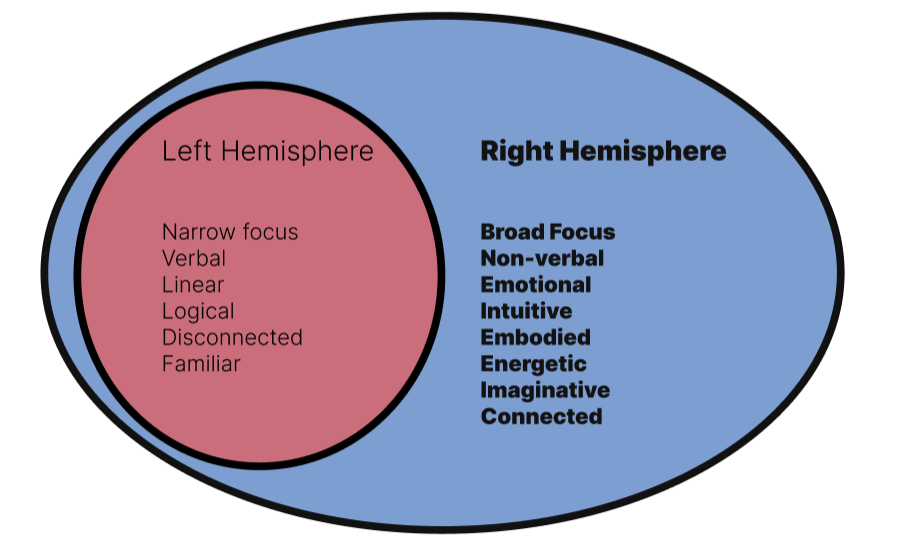Eleven Wisdom Tools

The Accelerating Wisdom series concluded this last weekend. Over the course of this year I’ve interviewed 8 world-class experts across a wide range of topics. One of the primary goals was to emerge with practical tips and tools that could enhance both your wisdom and your daily wellbeing. Because they are essentially the same thing.1
The definition of wisdom I like the most is: “doing exactly the right thing at the right time.” Often this means rebalancing towards our brain’s holistic right hemisphere so it can help direct our left hemispheric attention and agency. In short: our right hemisphere is better at telling us what to do, and when. This means amplifying the characteristics of the right hemisphere, below.

When I launched this series, I made sure to emphasize that accelerating didn’t mean “hacking.” Short cuts on this path can take you into bad neighbourhoods. It’s risky to take even the most basic spiritual technologies out of context and lineage. These kinds of tools and practices should be pursued in a balanced ecology and loving community.
Here are the practices that have emerged from my own research and experience, as well as the world-class experts from each episode in the series.
- “The Values Bracket.” The order of this list is designed to address the most common question I get from my 1:1 work with people at the start of a life transition: “where do I start?” The Values Bracket is an incredibly simple, effective and intense tool to use at the start of any exploratory journey. Get a pen and a piece of paper. Write a column of numbers downwards from 1-16. Next to each number write down something that’s important to you. I could be exercise, travel, your kids, time with family. Specific is good. But don’t overthink it. Then take #1 and match it against #16. So if you have “running” against “travel”, pick which is more important to you. There are no right answers, just what you feel. Then do it for each pair, e.g. #2 and #15, until you’re left with 8 values. Do the same deathmatch until you’re down to the final 4. Then 2. Then 1. You’ll notice that it can get really challenging, really fast.
- “Resonance Test.” Compile a list of every quote, story, movie or song that has resonated with you. Reflect on the commonalities. This builds a sense of personal resonance and a stronger link to your unconscious values. When something resonates with you, what does it resonate with?
- “Energy Journal.” Keep a daily journal where you track what raises and lowers your energy levels. Notably this practice was independently recommended by both Devin Martin and Anne Laure Le Cunff. The right hemisphere is somatic and energetic and it’s a more accurate guide during times of transition and uncertainty. Anne-Laure Le Cunff wrote a great guide to "becoming the anthropologist of your own life."2
- “Life Experiments.” In all my years of coaching and research this has been easily the single most powerful tool. Can you create something enjoyable but vulnerable with the aim of helping others? Did you see a response or synchronicity after offering it to the world? This is the fastest way that you can proactively bring positive attractors into your own life. Anne-Laure Le Cunff’s interview was a wealth of practical information on structuring and conducting these transformational experiments.
- “Somatic Meditation.” This is the practice of attuning your body to fundamentally subtle forces of attractors. I have personally really enjoyed Somatic Descent (as recommended by River Kenna) and Philip Shepherd’s Elevator Shaft Meditation.
- “Presence Practice.” Becoming more present all the time is essentially a primary prize in the pursuit of wisdom. Wisdom means correctly knowing what to pay attention to, and when. Pay close attention to subtle signals in your own body all the time, especially when you’re directly interacting with other people. As recommended by Allison Paradise, one specific way to enhance your presence in dialog is to move away from free-associating with another person’s comments and respond to them with open curiosity.
- “Accelerating Expertise.” It’s a common observation that wisdom requires suffering and experience. What’s less well explored is that both “suffering” and experience can be deliberately accelerated through getting rapid reps (often as few as 60). You can also accelerate your acquisition of relevant information for your intuition to draw from. Whether human mythology, biography or business stories, read widely and voraciously in the area where you want to build your intuition. Cedric Chin’s lecture discusses how to practice maintaining an adaptive worldview while doing so. Strategic rehearsals are the application of this concept to a business context.
- “Emotional Granularity.” If unconscious emotions and intuition come prior to thoughts, having a wide range of words for your emotions helps determine how effectively you navigate the world. A more precise link to your embodied unconscious also means a much clearer connection to your database of embodied experience, in business specifically and life generally. Buy or print an emotion chart and put it somewhere prominent in your house. Then challenge yourself and your family to be more specific in your self-expression. Locating the emotions in your own body adds an extra layer of hemispheric integration.
- “Sending Love.” Bear with me; because this probably sounds cheesy. But it is a practice that’s both simple and incredibly powerful. Simply imagine the person you want to send love to, and then wish them to be happy and healthy with all of your heart. Emerging consciousness theories suggest this may have more of a direct positive impact on OUR reality than we think. You can do it with public figures or friends and family. This is especially powerful with people you strongly dislike, as it may also mirror parts of yourself you are rejecting. Moreover, the felt-sense of “love” seems to be how the attractor acts on us, so attuning your thoughts to that frequency might be incredibly beneficial in helping guide your life path. It’s equally helpful to notice what blocks that feeling, particularly what you dislike about yourself and others.
- “Dream Work.” I’m only putting this later on the list because of how generally neglected this ancient technology tends to be in our society. Recommending people work with them dreams tends to raise eyebrows, especially in a business context. A good start is to keep a dream journal every morning. As recommended by Dan Lawrence, try and treat your dream imagery as objective, and take time before rushing to analyse it. The benefit of utilising the period between sleeping and waking to generate fresh insights was something that has repeatedly emerged from this series.
- “Reframing Your Reality.” The most “woo” practice also has the greatest potential impact. Treat the external world as conscious, intelligent and ultimately loving. As suggested by Dr. Mona Sobhani, look for lessons and patterns in your life within the context of prompts to make you more open and loving. Look for coincidences and synchronicities that reflect signposts along your path.
I try not to recommend things I either haven’t tried or don’t do regularly, but here are a selection of other tools and practices that have emerged from the series: meditation, right hemispheric drawing, incubation (darkness retreats). Devin Martin also recommended the Art of Living breathwork course.3
To reiterate, you will have noticed that none of these tools are “hacks” or short cuts. And although they are often incredibly effective, they are also relatively low-intensity. All the same, pretty much every single spiritual pursuit can benefit from a mentor, partner and community. Please also share what has worked for you!
1 A recent study found that wisdom is the best predictor of life satisfaction in both men and women, and can offset the negative influences of aging. Wisdom has a greater influence on life satisfaction in older adulthood than health, socioeconomic status, financial situation, environment, or social engagement. Thirty years of wisdom research has shown that it correlates with how good you feel and how much you’re growing.
2 Boyd Varty recommended an almost identical approach on a recent podcast with
Scott Britton. First allow yourself to sit in the uncertainty of not knowing your next direction, then attune to what pulls your energy.
3 Our community took two three-day introductory sessions, with generally positive feedback. For me the “yogic coffee” breathing exercise was incredible at producing alertness in less than 2min. But it hasn’t “stuck” as a regular practice.




